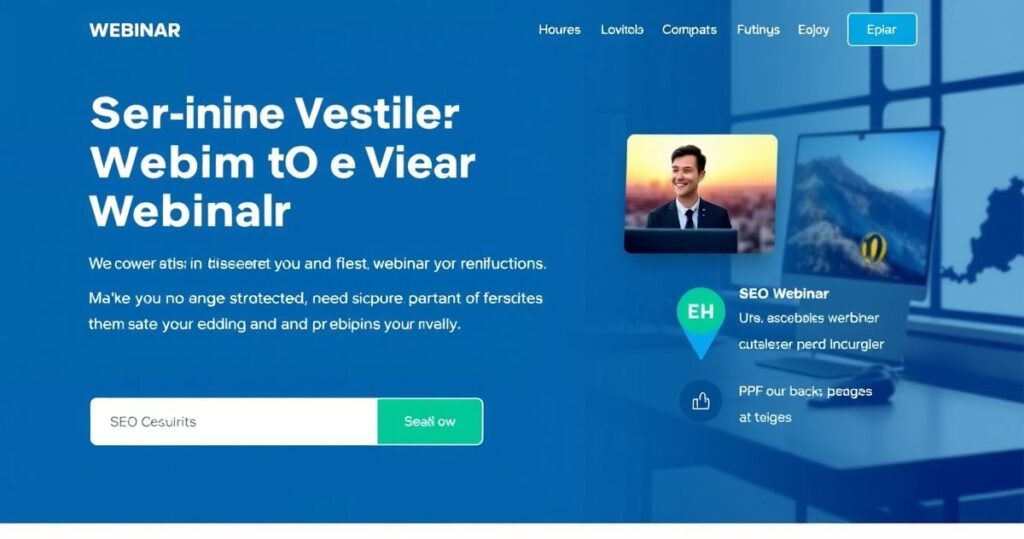Best SEO Practices for Webinar Landing Pages

Best SEO Practices for Webinar Landing Pages to Boost Registrations
Creating a high-converting webinar landing page isn’t just about design and copy—it’s about making it discoverable. Imagine crafting the perfect landing page, only for it to get buried under a sea of search results. Frustrating, right? That’s where SEO comes in. By optimizing your webinar landing pages for search engines, you can attract the right audience, increase registrations, and ultimately drive more conversions.
Let’s break down the best SEO practices for webinar landing pages, step by step.
Why SEO Matters for Webinar Landing Pages
First, let’s address the elephant in the room: why bother with SEO for a one-time event like a webinar? After all, the page might only be live for a few weeks. Here’s the thing: even short-term pages can still benefit from SEO.
Think of it this way: if your landing page ranks for relevant keywords, it can attract organic traffic long before the webinar date. Plus, a well-optimized page can serve as a template for future events. And let’s not forget the ripple effect—SEO can boost your overall domain authority, making it easier to rank other pages down the line.
Keyword Research: The Foundation of SEO
Before you start optimizing your landing page, you need to know what your audience is searching for. Keyword research is the backbone of any successful SEO strategy.
Here’s how to do it right:
-
Focus on Long-Tail Keywords
Instead of targeting broad terms like “webinar,” aim for more specific phrases like “best SEO practices for webinar landing pages” or “how to create a high-converting webinar page.” These phrases are less competitive and more likely to attract qualified leads. -
Use Tools Like Google Keyword Planner or SEMrush
These tools can help you identify search volume, keyword difficulty, and related terms. Don’t just focus on volume—look for keywords with intent. -
Analyze Competitors
Check out what keywords your competitors are targeting. Tools like Ahrefs or SpyFu can give you insights into their SEO strategies.
Optimizing Your Landing Page Content
Now that you’ve identified your keywords, it’s time to incorporate them into your landing page. But remember, SEO isn’t about stuffing keywords—it’s about creating a seamless user experience.
Here’s how to optimize your content:
-
Write a Compelling Headline
Your headline should include your primary keyword and grab attention. For example: “Master SEO for Webinar Landing Pages: A Step-by-Step Guide.” -
Use Keywords Naturally in the Body
Include your keywords in the first 100 words, but don’t overdo it. Aim for a keyword density of 1-2%. -
Leverage Subheadings (H2, H3)
Break up your content with subheadings that include secondary keywords. This improves readability and helps search engines understand your content. -
Add a Strong Call-to-Action (CTA)
Your CTA should be clear and action-oriented: “Register Now” or “Save Your Spot.”
Technical SEO: The Backbone of Ranking
No matter how great your content is, technical issues can tank your SEO. Here are the must-dos:
-
Optimize Page Speed
Slow-loading pages are a conversion killer. Use tools like Google PageSpeed Insights to identify and fix issues. -
Mobile Optimization
Over 50% of web traffic comes from mobile devices. Ensure your landing page is responsive and loads quickly on all devices. -
Use Meta Tags
Write a compelling meta title and description that includes your primary keyword. Keep the title under 60 characters and the description under 160. -
Enable SSL Encryption
Secure your page with HTTPS to build trust and improve rankings.
Design Elements That Boost SEO and Conversions
Your landing page design plays a crucial role in both SEO and conversions. Here’s how to get it right:
-
Use Engaging Visuals
Add images or videos that complement your content. Optimize them with descriptive alt text that includes keywords. -
Keep It Simple
A cluttered page can overwhelm visitors and hurt your SEO. Stick to a clean, minimal design that guides users to the CTA. -
Include Social Proof
Testimonials, reviews, or case studies can build trust and encourage registrations.
Real-World Example: How XYZ Company Doubled Webinar Registrations
Let’s look at a real-world example. XYZ Company wanted to increase registrations for their upcoming webinar on digital marketing trends. Here’s what they did:
- Conducted keyword research and targeted “digital marketing trends.”
- Optimized their landing page with keyword-rich content and engaging visuals.
- Improved page speed by compressing images and enabling caching.
- Added a countdown timer and social proof to create urgency.
The result? They doubled webinar registrations and saw a 30% increase in organic traffic.
Common Mistakes to Avoid
Even the best-laid SEO plans can go awry if you’re not careful. Here are some pitfalls to avoid:
-
Ignoring Mobile Users
If your page isn’t mobile-friendly, you risk losing a huge chunk of your audience. -
Overloading with Keywords
Keyword stuffing can lead to penalties from search engines. Keep it natural. -
Neglecting Analytics
Use tools like Google Analytics to track performance and make data-driven decisions.
Final Thoughts
Optimizing your webinar landing page for SEO isn’t just about rankings—it’s about creating a page that converts. By combining keyword research, technical SEO, and persuasive design, you can create a landing page that attracts, engages, and converts.
Now, here’s the million-dollar question: are you ready to take your webinar landing pages to the next level?
Feature-image-description
A sleek, modern webinar landing page showcasing a crisp headline, engaging visuals, a clear call-to-action, and user-friendly design elements. The image emphasizes SEO optimization and conversion-focused features.



